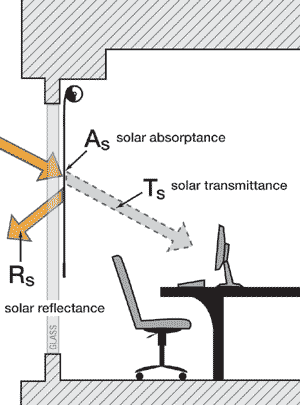Daylight in the Office Space
The Fabric Matters
Regardless of whether or not a solar shade is controlled manually or electronically, specifying the right shade fabric is critical to managing the daylight in a space successfully. The shading system's capacity for reducing glare, preserving outdoor views, providing privacy, protecting interior furnishings from UV damage, and minimizing solar gains is determined by the unique characteristics of the shade fabric selected. The openness factor of the fabric, the color of the fabric, and the composition of the fabric each shapes how the shade will interact with and manage the sun's light and heat energy, also known as solar radiation.
As solar radiation passes through the glass window, the fabric determines the amount of solar radiation that is transmitted into the interior building, absorbed by the shade, or reflected back outside.
|
||||||||||||||
Solar Performance Metrics
The solar performance metrics that define the functionality of the fabric are: solar transmittance, solar absorptance, solar reflectance, and visual transmittance. Solar transmittance (Ts) is the percentage of solar radiation that passes through the fabric. Solar absorptance (As) is the percentage of solar radiation absorbed by the fabric. Solar reflectance (Rs) is the percentage of solar radiation reflected back out by the fabric. Each of these performance metrics is inextricably linked together in the following relationship:
Ts+As+Rs=100 percent present solar radiation.
Visual transmittance (Tv) is the percentage of glare-causing visible light that passes through the fabric. Lower values indicate greater glare reduction. For example, a Tv of 14 percent indicates a glare reduction of 86 percent.
Solar performance metrics measure how fabrics with different openness factors, in different colors, and different compositions respond to solar radiation, providing a foundation for fabric comparison and a guideline for fabric specification.










